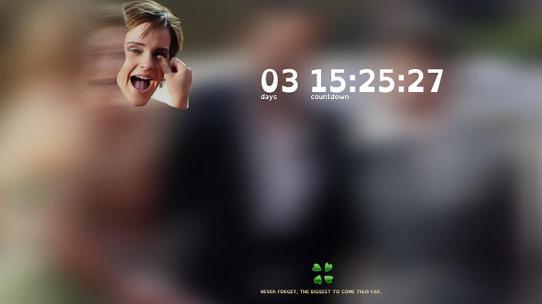Trending: Emma Watson
Posted: September 24, 2014 Filed under: Uncategorized | Tags: 4chan, actor, celebrity culture, culture, feminism, films, heforshe, marketing, men, speech, UN, women Leave a commentI tell you what, it’s been a mad week for Emma Watson. What began as a powerful speech made by the UN Women’s Goodwill Ambassador, suddenly turned into an online threat that ended as a marketing strategy for online censorship. Could you tick any more boxes on the media-and-communications-front?
Earlier this week, Emma Watson made an inspiring speech at the UN Women’s #HeForShe campaign presentation in Uruguay, encouraging men to “climb aboard the feminist train and end gender inequality once and for all“.
‘Feminism by definition is: “The belief that men and women should have equal rights and opportunities. It is the theory of the political, economic and social equality of the sexes,’ she said.
Sadly, the #HeForShe campaign became shadowed quite quickly by a big steaming pile of shit.
On reporting the event, The Daily Mail decided to cut straight to the important information about the campaign: “[Watson] wore an elegant oatmeal dress with blazer structuring on top and pleated skirt on the lower half”. Wow, a pleated skirt!
“She later changed into a sleeveless black silky midi-length dress for a party in honour of the occasion,” The Daily Mail continued to report with a dizzying amount of photos of her outfit AS IF THEY DIDN’T QUITE UNDERSTAND THE WHOLE CONCEPT OF THE ACTUAL CAMPAIGN THEY UNFORTUNATELY FORGOT TO REPORT ON.
Meanwhile, The Debrief, shared an article with an attached video which essentially was a montage of Watson in various outfits at film premiers. “We’ve always known Emma Watson was smart as a tack”, they wrote. “[Watson] could have happily sat atop her cushy Harry Potter millions, but instead went to Ivy League US college Brown, graduating with honours.”
It’s like WOW?? A woman?? Who has lots of money from being in films?? But instead chose to go to college?? The Debrief needs to try and act less surprised about a woman being intelligent.
Imagine if these articles were written about a famous male actor doing a speech– oh wait.
No one seems too surprised that DiCaprio knows what he’s talking about. While Watson gets reported on her outfits and the shocking fact she went to college, Dicaprio just gets quoted on important parts of his speech.
Thankfully, Facebook is doing it right with Watson trending online for the actual speech.

Source: Facebook
Of course, the shit didn’t end here. It eventuated that a (probably fedora-clad) 4chan user was threatening to reach into the cloud and leak Watson’s nudes, via EmmaYouAreNext.com.
If there were any clearer a message that we need feminism, this was it. “If only her nudes got leaked and she had the load on her face. Her feminism kick would be over,” one commenter on the 4chan site wrote. Okay then.
And just when you thought it was all going so terribly, it actually got worse. …

Source: http://www.abc.net.au/news/2014-09-24/emma-watson-threats-actually-stunt-to-shut-down-4chan/5766882
#Shutdownrantic #shutdown4chan Rantic is hijacking #heforshe and @EmWatson for monetary gain! pic.twitter.com/fMdbakGLWg
— Shane L (@WayneTheCaveman) September 24, 2014
It’s hard to comment on this without getting insanely angry. Sure, Rantic can start their own little campaign aiming to #shutdown4chan. But promoting this campaign by faking a website that was threatening an actor who had done nothing wrong and simply made a speech on feminism? This is not the right way to go about it Rantic.
Rantic? Are you insane?
As a result, many people were worried this would shadow Watson’s speech and it seemingly has for the most part.
So, of course, what we need to remember is that Emma Watson made us all proud this week by making a speech as the UN Women Goodwill Ambassador for the #HeForShe campaign. Sure, she was wearing a dress. No, we don’t need to know about it. No, her nudes aren’t being leaked.
And yes, Rantic are a bunch of dicks.
The Fine Line of Accurate Racial Representations
Posted: May 6, 2014 Filed under: BCM310 | Tags: audience, blackface, communication, controversy, culture, entertainment, ethnicity, hey hey its saturday, media, media issues, midsomer murders, minorities in America, misrepresentation, race, racism, representation, television, underrepresentation, worldwide audience Leave a comment
Misomer Murders – is this a racist show? / Source: http://www.thetimes.co.uk/tto/life/article2947513.ece
In 2008, a study found that while 32% of the US population was caucasian males, they were represented on cable TV 57%, while other demographics such as Latino men, who made up 8% of the population, were only represented 1%.
Racial and ethnic minorities have always been misrepresented and underrepresented in the media, and today these minorities are still not represented accurately, begging the question whether enough is being done to fairly portray all races and ethnicities.
Even if we believe that more fair and accurate representations of minorities are on offer these days, media producers are constantly weighed down by the Burden of Representation.
Following the 9/11 attacks, there was a conscious effort to highlight that Arab and Muslim Americans were not the enemy, that Arab and Muslim terrorists were. However, TV shows began to portray these minorities in America as the “unjust victim[s] of post-9/11 discrimination”, which would be all well and good if it didn’t mean concluding that it is “inevitable that Arabs and Muslims will have to deal with discrimination” (Alsultany, 2013).
Marginalised groups were often portrayed as the bad guys, but this sympathetic approach is no better. What we see here is an attempt to portray these minorities in a positive light, that actually comes off as allowing the audience to feel sympathetic for ‘the enemy’ (Alsultany, 2013).
There is a fine line between an accurate representation and an unfair one, even if the intention is good.
Other such cases include Australia’s 2009 debacle on Hey Hey It’s Saturday, where men wore ‘blackface’ to create a comedic performance parodying The Jackson Five. What was supposed to be taken as comedy created controversy linked to black history where ‘blackface’ theatre depicted black people in “a degrading manner” (Mahony, 2009). Here the fine line between comedy and racism was moon-walked along.
In 2011, BBC TV show Midsomer Murders’ producer came under fire for saying that putting ethnic characters in the show would not work. Was this wrong? While it appears discriminatory, the caucasian cast of the show accurately portrays the English village. “The point about Midsomer Murders is that, in a village in Midsomer, all outsiders are equally unwelcome whatever their colour. If your family has lived here for 300 years, they’re likely to be white. That’s quite obvious.” (Horowitz, 2011).
This show is merely being historically and geographically accurate. Is it still wrong of them to not have ethnic characters?
I think what we need to realise is that an accurate presentation of an ethnicity or race is not necessarily that of an overly positive and sympathetic image, but the all-encompassing collective of a wide range of different media that portrays all different aspects of these groups. With this rich collection of media, our minds can be opened to the different stories that exist within these groups and the narrow-minded stereotypes we have learnt over time can be thrown away. This is the only way we can escape the dangers of the single story.
REFERENCES
Alsultany, E 2013, ‘Arabs and Muslims in the Media after 9/11: Representational Strategies for a “Postrace” Era’, American Quarterly, vol.65, no.1, < http://muse.jhu.edu/journals/american_quarterly/v065/65.1.alsultany.html >
Clarke, M 2010, ‘White Australia has a blackface history’, Overland, < http://overland.org.au/previous-issues/issue-199/feature-maxine-clarke/ >
Easton M 2011, ‘Is it ever OK for TV dramas to be all-white?’, BBC News, < http://www.bbc.com/news/magazine-12748293 >
Mahony, M 2009, ‘What’s all the fuss about “blackface”?’, Crikey, < http://www.crikey.com.au/2009/10/08/crikey-clarifier-whats-all- the-fuss-about-blackface/ >
Singh A 2011, ‘Midsomer Murders is not racist, says Anthony Horowitz’, Telegraph, < http://www.telegraph.co.uk/culture/tvandradio/8383788/Midsomer-Murders-is-not-racist-says-Anthony-Horowitz.html >
The Ellen Selfie: what it tells us about #selfie culture
Posted: March 24, 2014 Filed under: BCM310 | Tags: audience, culture, ellen, entertainment, film, media, media space, private sphere, public sphere, self-documentation, selfie, selfies, sousveillence, television, twitter 1 Comment“Can you guys help me pick a filter? / I don’t know if I should go with XX Pro or Valencia / I wanna look tan / What should my caption be? / I want it to be clever / How about ‘Livin’ with my bitches, #LIVE’?”
While this piece of music entitled #SELFIE by legendary musicians, The Chainsmokers, may be so overwhelmingly beautiful that it is difficult to listen to without quietly weeping at its perfectness, the lyrics above do encapsulate the vanity that comes with self-documentation.
We all know what a selfie is – in fact, the majority of us have taken a selfie – but we are always quick to condemn those who take them for how vain they seem. But there is more to the mere selfie than meets the eye – for a selfie is not just a “visual communication of where we are, what we’re doing” but it is also communication of “who we think we are, and who we think is watching.” (Saltz, 2014). It is a representation of oneself that we want people to see.
There is a growing obsession for sousveillence. Actor James Franco wrote that selfies are more than vanity and are “little visual diaries that magnify, reduce, dramatize–that say, ‘I’m here; look at me.'” In a society where people’s actions can often be overlooked, a need for these actions to be validated exists – and this can be simply solved by self-documentation (Andrejevic, 2004, pp.110).
What’s really interesting is that selfies are a “social comment on the erosion between public and private spheres in daily life” (Aufderheide, 1997). Posted publicly online, you can see into the personal lives of people you don’t even know.
Why was The Ellen Selfie so popular? Everyone is used to seeing these celebrities appearing in films, but it is always a novelty to see them appear in a selfie being themselves and showing you their own lives. With the selfie taken at the Oscars, you end up with a photo that somehow shows a ‘private’ side to a public event.
While the selfie-taking was televised, it almost feels like you’re looking at an ‘intimate’ moment with the actors. The Ellen Selfie tells us that while selfie culture is the norm, it does bring up much conversation on public and private spheres, as it is difficult to distinguish what is public and what is private when it comes to self-documentation.
(But really, the question we should be asking is this.)
REFERENCES
Andrejevic, M 2004, Reality TV: The Work of Being Watched, Rowman & Littlefield Publishers.






